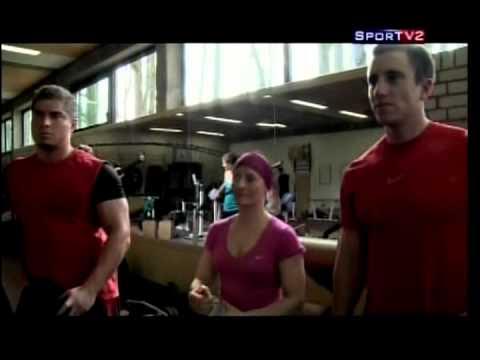Why The Olympics Almost Banned This Shoe
Summary
TLDRThis video delves into the controversial world of 'tech doping' in sports, exploring the fine line between innovation and unfair advantage. From banned swimsuits to cutting-edge running shoes, it examines how technology like Nike's Vaporfly has revolutionized performance but stirred debate. The script challenges viewers to consider the spirit of sports and the role of tech in enhancing—or possibly cheating—human capabilities.
Takeaways
- 🏃 Sports gear advancements have sparked debates on whether certain technologies provide an unfair advantage, termed as 'tech doping'.
- 🛑 Regulators often ban equipment that increases the risk of injury to athletes or fans, such as aluminum bats in baseball.
- 🤔 The 'spirit of the sport' is a vague concept, leading to more specific questions about the fairness and accessibility of technology in sports.
- 🥽 Goggles in swimming were initially controversial but eventually accepted, while other technologies like the Speedo LZR racer were banned for enhancing performance.
- 📊 The introduction of the LZR racer suit in 2008 led to a significant improvement in swimming records, raising questions about its impact on fairness.
- 👟 The development of 'super shoes' in running has increased energy return rates, with some arguing they give an unfair advantage and others seeing them as a natural progression of sports technology.
- ⚠️ Regulatory bodies have attempted to limit the advantages of super shoes by imposing restrictions on design elements like foam height and the use of carbon fiber plates.
- 👀 The debate extends to prosthetics, as seen with Oscar Pistorius and Blake Leeper, where the line between correcting a disability and enhancing performance is blurred.
- 📏 The Olympics have used specific rules, like the MASH rule, to determine the eligibility of athletes using prosthetics, which can be controversial and complicated.
- 🌐 The script touches on the broader implications of technology in sports, questioning where to draw the line between innovation and unfair advantage in various aspects of life.
- 🔍 The video aims to explore the cutting edge of sports technology, questioning what is allowed and what is not, and the philosophical and practical implications of these decisions.
Q & A
What is the main debate the video script addresses?
-The main debate the video script addresses is the concept of 'tech doping' in sports, where the line between enhancing performance through technology and gaining an unfair advantage is blurred.
What does the term 'tech doping' refer to?
-'Tech doping' refers to the use of physical gear or technology to gain an unfair advantage in sports, which is a controversial topic as it can make athletes perform beyond what is traditionally considered possible.
Why are certain sports gear banned in professional sports?
-Certain sports gear is banned because it may increase the risk of injury, go against the spirit of the sport, or provide an artificial enhancement to a player's performance that is deemed unfair.
What was the significance of the LZR racer suit in swimming?
-The LZR racer suit was significant because it used advanced technology to mimic shark skin and streamline swimmers' bodies, leading to a surge in world record performances and subsequent debates about its fairness.
What is the role of the Nike test lab in the video script?
-The Nike test lab is where the video script's host explores and demonstrates the technology behind some of the most controversial sports equipment, including the energy-returning running shoes.
What is the energy return rate in running shoes, and why is it important?
-The energy return rate in running shoes refers to the percentage of energy exerted by a runner that is returned to boost them into their next stride. It is important because a higher energy return can significantly improve a runner's performance.
What are the specific rules that regulators implemented regarding energy-returning shoes?
-Regulators implemented a 40 mm foam height limit and a rule stating that shoes cannot have more than one carbon fiber plate. Additionally, they required that all shoes must be available for public purchase at least four months before being used in competition.
How did Nike respond to the new regulations on energy-returning shoes?
-Nike expressed concern that the new regulations would stifle innovation and issued a statement arguing against the rules, stating that their goal is to push human potential forward, not to create an unfair advantage.
What is the controversy surrounding the use of prosthetic legs in sports, as exemplified by Oscar Pistorius and Blake Leeper?
-The controversy revolves around whether the use of prosthetic legs provides an unfair advantage by enhancing performance beyond what an able-bodied athlete could achieve, and how to fairly determine what constitutes a 'correction' versus an 'enhancement'.
What was the MASH rule, and why was it significant in the case of Blake Leeper?
-The MASH rule, or max allowable standing height, was significant in Blake Leeper's case because it was used to disqualify him from competition on the grounds that his prosthetic legs made him taller than he would be naturally, which was not considered in the case of Oscar Pistorius.
What broader implications does the script suggest about the role of technology in sports and society?
-The script suggests that the role of technology in sports and society is a complex issue that goes beyond the field of play. It raises questions about innovation, fairness, and the ethical considerations of using technology to push human capabilities.
Outlines

This section is available to paid users only. Please upgrade to access this part.
Upgrade NowMindmap

This section is available to paid users only. Please upgrade to access this part.
Upgrade NowKeywords

This section is available to paid users only. Please upgrade to access this part.
Upgrade NowHighlights

This section is available to paid users only. Please upgrade to access this part.
Upgrade NowTranscripts

This section is available to paid users only. Please upgrade to access this part.
Upgrade Now5.0 / 5 (0 votes)





